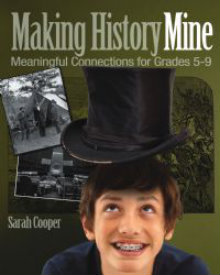Helping Our Students Care about History

This summer we’ve been reading a 2009 book from Stenhouse Publishers – Making History Mine. Author Sarah Cooper is a veteran history teacher who perceives that missing emotional connection and has created learning experiences that help students bridge the gap between “now” and “then.”
The book’s thesis or pedagogical perspective might be summed up this way: History is about people, and I am a person–therefore history is about people like me. With each lesson or unit described in the book, Cooper reaches out to personalize history and bring it back to the present for even the most reticent students.
An accessible book

- The Role of the Individual: Assessing Who Makes History
- How Opinions Become History: Analyzing Point of View
- Global Citizenship: Learning to Evaluate Ethics and Solve Problems
The text provides a lot of useful and “universal toolkit-like” features that can be applied to any discipline of social studies. Many of Cooper’s approaches are interdisciplinary, lending themselves well to a collaborative teaching environment. Because of this, though she wrote this book when state standards were the norm, it can be easily adapted for use with Common Core.
This book affirms both teacher and students as individuals. It focuses much more on the enduring understandings of learning than the more clinical term of “coverage” that is often the focus in history classes.
Instead of looking strictly at content, the ideas woven through the text are larger goals such as how to increase motivation and connection, and how to take learning a step beyond pure content through ethics and action. Cooper then explains how to use social studies content and processes to further those goals.
Motivating through shared human interests
For Cooper, the primary way to reach students is to increase motivation by helping them connect to the human-ness of history. People, perspectives, primary sources, and mystery are at the forefront in many of her lessons. For example, in Chapter 3, she has the students get to know the complexity of the person of Benjamin Franklin through a close 
The way in which Cooper explains her instructional methods for getting the students to close read is very helpful for the teacher. Putting the quotation on the left in the chart and the students’ analysis on the right, she offers students multiple ways to unpack the text: “If you were a delegate at the convention, what would have been your biggest fear about signing the Constitution?” (47)
While the students are busy puzzling this Bloom’s-Taxonomy-friendly question, they are also pinning a real human emotion on a historical figure, and putting themselves in Franklin’s place. This exercise, and many others that function similarly, go a long way toward making the people of history more than just words on a page.
Seeing oneself in the larger themes
For Cooper, history isn’t just about looking at others, it’s about looking at the self in relation to others. Each of her units have guiding questions that thematically connect personal experience to the big ideas/enduring understandings of the unit. Some examples:
- If you were a ruler, how would you ensure that people would respect you?
- Which form of government would you most like to live under, and why?
- How does region or ethnicity affect our life? How has it affected governments in the past or today? (14,15)
What shines through in each and every example lesson, project or unit that Cooper shares in Making History Mine is that, for her, history is about the uniqueness of the historical experience while at the same time is also about the uniqueness of the individual studying the history. Again, while this book has myriad examples of projects that any teacher can use, the goal of this sharing, and of all these projects, is to truly make the history personal and accessible to the student.
So what?
Many teachers (including us) can find ourselves mired in the past when teaching history, and we may struggle to make connections to the present. Cooper addresses this need on a few different levels; she not only has a chapter about making connections to current events, but she also makes a strong case for an ethics component to history study. For her, it’s 
One of the projects she explains is an Op-Ed project, in which students write actual opinion columns about a variety of world topics, such as the environment, government structure, social welfare, and technology (125).
She takes the idea a step further in her chapter on making global citizens: she has her students evaluate both negative and positive actualization of values. A negative example that she gives is the Romans destroying Carthage; students analyze motivations, regrets, and ultimately the ethical (or in this case, unethical) component of actions during war (168).
She makes it a point to include these conversations about history that are rooted in value judgments because they are the kinds of ethical questions that come up again and again in history–and in the present.
Each of her approaches is designed to move the students both backwards and forwards–to look at the past through a lens of their own experience in the present, but also to look toward the future with all of these lessons in mind so that they can become more contextualized themselves as they make their own “historical” choices.
Ideas to help history’s stories come alive

Cooper
Sarah Cooper’s book makes a true argument for her philosophy of personal and connected history, but her book is more valuable for a history teacher than just that one overarching goal. In terms of the practical, and especially for a newer teacher of the subject looking for models of exemplary lessons, the text is full of helpful ideas. Cooper goes into great detail and shows actual student work, and her pedagogy is current, if not completely cutting-edge (there’s a five-year technology gap, for one thing).
But as history teachers, it is important for us too, to remember Cooper’s thesis. It is so easy to get caught up in the minutiae of teaching and content and skills and facts, that we forget that we are teaching about stories. Cooper’s book reminds the teacher of this and leads us down a path that helps our students make history’s stories come alive.






























